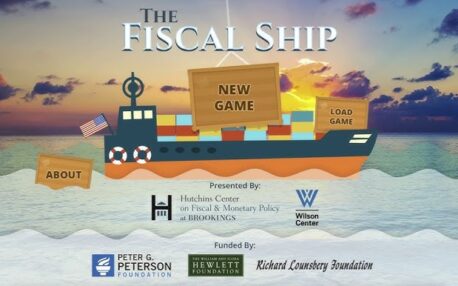The flagship, if you will forgive the pun, of the Serious Games Initiative during my tenure at the Wilson Center was the Fiscal Ship. It was the first game project I worked on at the Wilson Center and was developed in partnership with the Brookings Institution. It was on a topic that I have maintained that, generally, only people within the beltway would find fun: the federal budget.
Yet with the renewed nationwide interest in our federal budget and how we can reduce federal spending, I thought it would be beneficial to do a reflection.
Some History
The brainchild of a meeting of the “three Daves” (as the grant documents officially stated), The Fiscal Ship followed the legacy of the Wilson Center’s first game, Budget Hero, in topic and the overarching motive of putting people in the position of saving the United States from national debt and being a champion of fiscal responsibility. Players were challenged to pass policies that are talked about here in DC, and see how they could achieve their own platform of goals while also getting us out of national debt.
Unlike Budget Hero there were two specific audiences that we targeted for this game. Brookings led classroom engagement, including a treasure trove of resources for teachers. Even if you are not a middle school teacher, I would recommend those resources as they have explanations of the Congressional Budget Office projections and other sources of data that were used in the game, as well as videos on the future of the federal budget.
The Serious Games Initiative led the engagement with the 35+ crowd. In our field, this is an audience body that is often overlooked in the narrative of games because of the perception that games are for children. Turns out, games about the federal budget are for all ages; so in this next edition, we focused on policymakers.
Outreach and Engagement
The games produced by the Wilson Center on the federal budget have been played 4.5 million times worldwide. This year alone, over 750,000 people have visited the Fiscal Ship, with only approximately 11% from the United States. For a game about the US federal budget, that’s a pretty high audience.
This success is in part built upon the legacy of Budget Hero, the hard work of Brookings to get it integrated into as many classrooms as possible (it is featured on the Foundation for Teaching Economics lesson plans), and also a tiered approach to outreach focusing on both mass media on on-the-ground engagement. When it launched in 2016, the Fiscal Ship appeared in mainstream media outlets; we also had direct engagement with both stakeholders on the ground (e.g., teachers) and in DC (on and off the Hill). I have personally played the Fiscal Ship in demos for everyone from high school students to Members of Congress.
One of the things I learned from getting a doctorate in communication is that the best way to make an impact on people is face-to-face. When I started at the Wilson Center, one of the first things I did was organize a series of engagements around the Fiscal Ship we called “Budgets and Brews.” The premise was simple: we gathered over 200 Congressional staff off the Hill in a room and challenged them to play the Fiscal Ship. If you know anything about Congressional staff, it is that they are highly intelligent, and highly competitive people. These events were widely attended, and also were a chance to connect and get feedback on the shape of the game.
Lessons Learned
The Fiscal Ship did not launch as a perfect product. We went through several updates on the game, adding resources for teachers (who wanted a way to print off plans that their students put in the game) and simplifying the introduction and instructions to the game (to make it faster to play).
There were consistent content updates; we added an “in the news” category to make it easier to navigate to timely fiscal policies that would impact our national debt in the long term. If you take up the challenge to play it, you can even see the projection for several policies from the current administration. The Brookings team continues to vet each of these policies through a bipartisan advisory board, both in terms of the explanations (for description of the policy, the arguments for and against) as well as the impact on national debt projections.
What I think led to Fiscal Ship’s success was its simplicity in the face of the very complicated topic of fiscal policy. It was quick to play (15 minutes or less), easy to navigate, and clearly showed the impact of specific policies on reducing debt. For those looking to recreate its success, I would encourage you to think in terms of these forms of accessibility. We often get bogged down with the complexities of policy, and for those of us who love public policy those complexities and tensions are what drive us. The number of white papers attests to that drive.
But when thinking of engaging the broadest audience possible, simplicity is key. This allows more people to be engaged and to gain entry into topics they may not otherwise engage with, by focusing on clear takeaways. And the sheer number of people who have played the Fiscal Ship, over reading any of those white papers, can attest to that legacy.

The games produced by the Wilson Center on the federal budget have been played 4.5 million times worldwide. This year alone, over 750,000 people have visited the Fiscal Ship, with only approximately 11% from the United States. For a game about the US federal budget, that’s a pretty high audience.
















